|

by Brandon Turbeville
January 05, 2016
from
NaturalBlaze Website
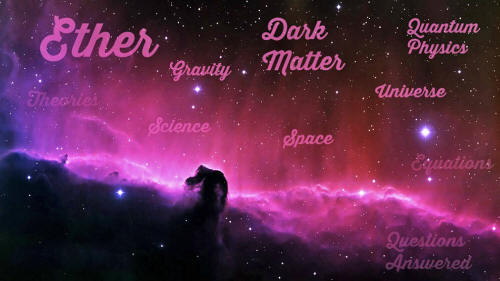
Source of
Gravity Defined in Quantized Ether?
Throughout the history of modern physics, scientists have theorized
about the existence of "dark energy" or
"ether," a substance that,
if it exists, envelops and fills everything - all space and all
reality.
Ether has often been theorized to be the
substance which is the conduit for the life giving force of the
universe.
Yet physicists throughout the years have argued about this concept
without ever reaching a consensus even regarding its existence, much
less its makeup or nature. Those who argue in favor of the existence
of this "ether" run into the problem of a lack of an ability to "quantize" it.
Those who argue against it run into the
problem of the conventional mainstream understanding of physics
which is unable to account for many aspects of reality - both
quantum and physical.
In
a paper entitled "Prodigal Genius - The
Life of Nikola Tesla"
(page 119),
Nikola Tesla
described the concept of ether by writing,
Long
ago he (mankind) recognized that all perceptible matter comes
from a primary substance, or tenuity beyond conception, filling
all space, the Akasha or luminiferous ether, acted upon by the
life giving Prana or creative force, calling into existence, in
never ending cycles all things and phenomena.
The
primary substance, thrown into infinitesimal whirls of
prodigious velocity, becomes gross matter; the force subsiding,
the motion ceases and matter disappears, reverting to the
primary substance.
If
Philosopher, Chemist, and Biophysicist
Francis V. Fernandes'
equations are correct, however, we may be at the cusp of a
scientific breakthrough that will change the face of the world of
physics and the world in which we live.
This is
because Fernandes claims that he has in fact quantized the mass of
ether.

If
Fernandes' calculations are correct, this changes the entire ball
game.
He
himself states that, once the mass of ether is known, solving a
number of "unknowns" in the world of physics becomes relatively
simple. The question of gravity, relativity, magnetism, and, indeed,
energy itself becomes answerable.
Thus,
Fernandes says that he went on to solve tens of equations and was
likewise able to solve tens of unresolved questions within the field
of physics. For
instance, the question of gravity and relativity, according to
Fernandes, once the mass of ether is known, can itself be solved.
Fernandes
suggests the equation below does just that,

But what
are the questions surrounding gravity and general relativity?
The Question At Hand
Marianne Freiberger,
in her article "Problems
of Gravity,"
sums up the lack of consensus on these principles by writing the
following:
"General relativity correctly describes what
we observe at the scale of the solar system," reassures Constantinos
Skordis,
of The Universities of Nottingham and Cyprus.
"It all works beautifully at this scale and
it has been tested."
The problems arise when you look at the Universe
at very small or at very large scales.
At the turn of the twentieth century people
realized that at very small scales, in the realm of atomic and
sub-atomic particles, the world looked very different from what
they had expected.
The
theory of quantum
mechanics grew out of
that realization and posed a new challenge:
the descriptions of
the fundamental forces of nature now had to be adapted to the
new quantum mechanical insights - they had to quantized (see Schr÷dinger's
equation - what is it? and Let
me take you down cos we're going to... quantum fields).
The problem is that general relativity stubbornly
refuses to comply in this undertaking.
"Einstein's theory cannot be easily quantized;
we can't find a quantum counterpart in the same way as we
found one for electromagnetism," explains Thomas
Sotiriou of
the University of Nottingham.
In fact, the problem of finding a quantum theory
of gravity is so challenging, and so important, many consider it
the holy grail of modern physics.
Another mystery arises when you look at the
Universe as a whole. Since 1929 physicists have known that the
Universe is expanding, a fact that came as a shock even to
Einstein: stars and galaxies are moving away from each other.
Nearly 70 years later, in the 1990s, observations
of far away objects also showed that this expansion is speeding
up.
General relativity cannot explain what causes
this acceleration. If we believe the theory, then we must
concede that there is something else out there, a mysterious
form of energy which drives the acceleration.
That something has been dubbed dark
energy.
"Dark energy is bizarre," says Skordis.
"It's not a particle, you can't detect it in
the lab. It's just a missing form of energy which must have
some peculiar properties. For example, it must exert
negative pressure, which is what drives accelerated
expansion. We just don't know what causes it."
(See here for
more on dark energy.)
Quantum physics offers one explanation for dark
energy.
According to this theory, the vacuum does not
really exist in the sense we usually understand it, as empty
space. Instead,
particles constantly pop in and out of
existence, resulting in a
vacuum energy,
an energy of space itself, which might be driving the
accelerated expansion. There's a number which measures that
vacuum energy, called the cosmological
constant, whose value
particle physicists can estimate.
The trouble is that this
estimated value is bigger than what observations suggest.
And not just a bit:
the two
values, observed and theoretical, differ by at least 60 orders
of magnitude (see this article
for more).
Although the estimate stemming from quantum
physics is rough and perhaps naive, the difference is so big
that something is clearly, very wrong.
These
problems, dark energy and the need to quantize gravity, provide
some of the motivations for meddling with general relativity.
And perhaps they are even connected.
"The very large and the very small [scale problems] are not
necessarily distinct," says Sotiriou.
"It is technically very challenging, but not inconceivable
that one could have an extension of general relativity that
deals with the large scale problems, which would at the same
time have a better behavior when it comes to quantization.
Maybe we can hit two birds with one stone."
But how
does one go about finding such an extension of general relativity?
The Answers?
Fernandes
suggests his quantization of ether and his equation below helps
answer these questions,

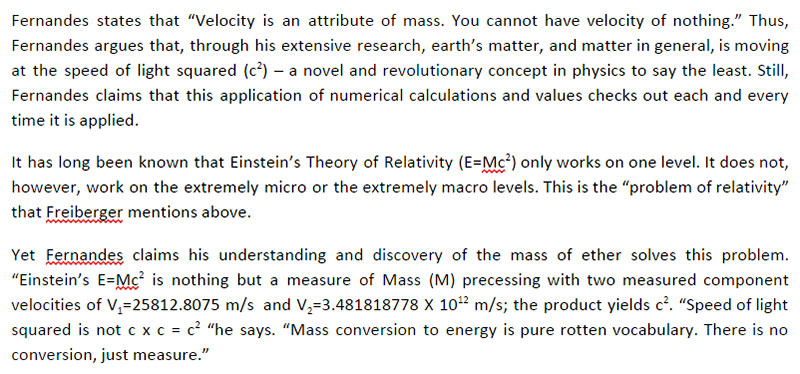
So how
did Fernandes arrive at his conclusion?
He
provides the following information:
Gravity of Earth is acceleration
of Ether
by
Francis V. Fernandes
December 2000
Leap of Imagination:
Gravitation energy or force is believed to be weak and nowhere
in magnitude to the electric force. I assumed the energy of
gravity to be equal to that of the electric energy.
Energy calculated by Newton's gravitation equation is the same
as energy calculated by Coulomb's electric equation.
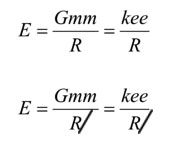
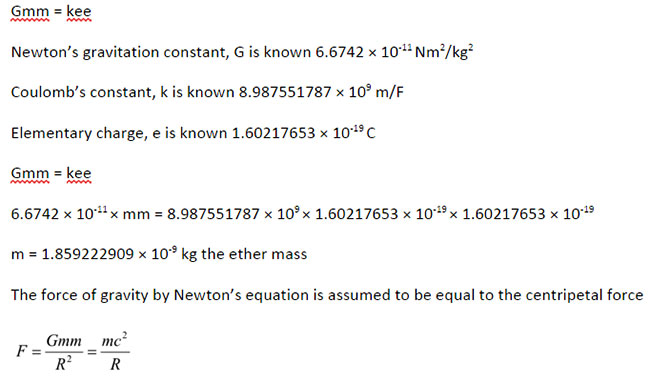
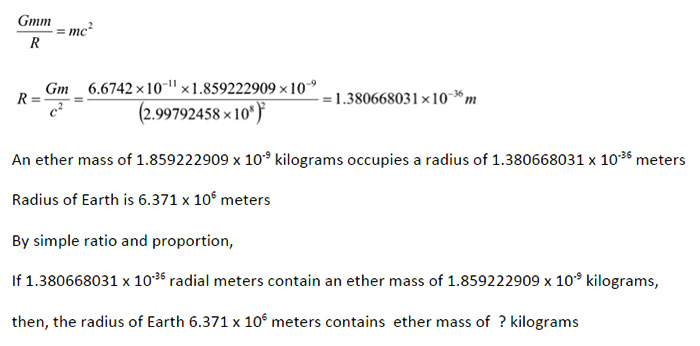
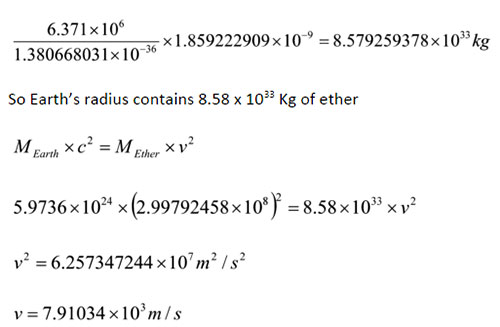
Acceleration due to Earth's gravity,


Back to
the question of the speed at which we, the earth, and matter in
general is moving, Fernandes suggests that we/matter are all moving
at the speed of light squared.
Fernandes
states,
"I
have shown that my discovery of 186-ether is the lower pulsate
limit of the Planck mass. Planck actually derived an ether mass.
The Planck length times the ether constant ratio K yields the
Planck mass. Hence, the Planck mass is an ether mass."
He
continues,
"Matter is at the speed of light squared as seen in the matter
of earth below. And mass is ether mass on the right side of the
equation."
He
continues:
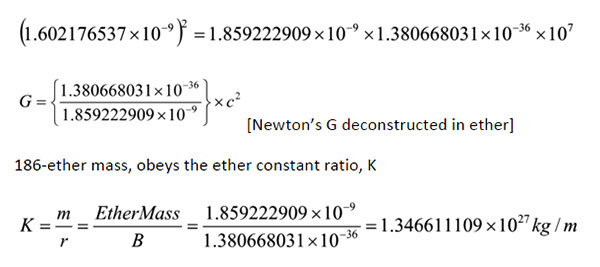
The ether
distribution to the power of 27 zeros in kilograms per radial meter
holds good at the atomic and galactic scales.
Fernandes
concludes that,
"Acceleration due to ether is gravity."

He
writes,
-
Mass of Earth, speed of light and tangential velocity
squared are known quantities.
-
Mass of something is the missing entity. This missing hidden
entity is the mass of ether.
-
Mass of Earth is at the speed of light
squared whereas Mass of Ether is at slowed velocity squared.

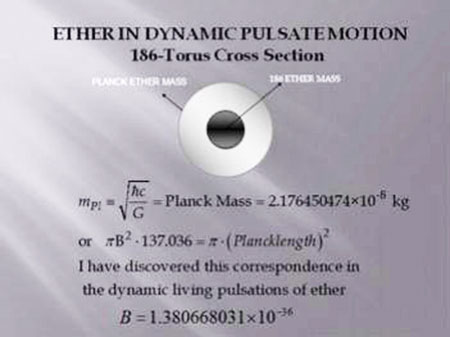
As
depicted above the ether radius is the lower pulsate limit of the
Planck length.
Yes, at
the heart of the Universe is ether in dynamic pulsate motion by a
factor of the Inverse Hand of God alpha number 137.036
Conclusion
The
mainstream physics community will no doubt immediately scoff at
Fernandes' claims.
However, mainstream communities often scoff at
"fringe" declarations until those "fringe" claims eventually become
mainstream themselves.
Regardless of how Fernandes' claims will be received, it is
important, for the sake of human civilization and the possibility of
greater scientific development that his claims be seriously looked
at and that his figures be put to the test.
Fernandes,
for his part, is willing for his claims to be put to the test and
for his figures to be challenged. He seems to welcome it, so sure he
is of the outcome.
If he is
right, his work will be some of the most groundbreaking physics
related breakthroughs in modern times.
We owe it
to ourselves to look further into it.
|
















